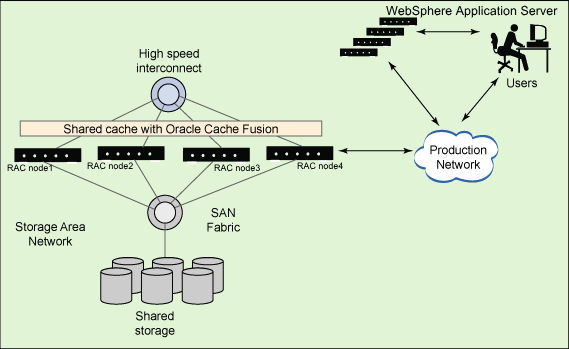Configuring Oracle Real Application Cluster (RAC) with the application server
Oracle Real Application Cluster (RAC) is a "share-everything" database architecture in which two or more Oracle RAC nodes are clustered together and share the same storage. The RAC nodes are connected together with a high-speed interconnect that enables fast communication between the Oracle nodes. The nodes can exchange various categories of data block ownership information during startup, lock information, exchange transaction information and data, and so on.
About this task
A typical Oracle RAC cluster consists of the following:
- Cluster nodes – 2 to n nodes or hosts, running the Oracle database server.
- Network Interconnect – a private network used for cluster communications and cache fusion. This is typically used for transferring database blocks between node instances.
- Shared Storage – used to hold the database system and data files. The shared storage is accessed by the cluster nodes.
- Production network – used by clients and application servers to access the database.
The following figure depicts a typical configuration for Oracle RAC:

Here are two of the many features that Oracle RAC provides:
- Oracle Notification Service (ONS) allows for Oracle RAC to communicate the status for the nodes, which are typically UP and DOWN events, to the Oracle Universal Connection Pool (UCP). To take advantage of ONS, you must configure the application server to use Oracle UCP instead of the application server's connection pooling feature. Read the technote on configuring Oracle UCP in the application server for more information on this process.
- Distributed Transaction Processing (DTP) is a feature that was introduced in Oracle 10gR2. When this feature is enabled, Oracle will ensure that all in-flight prepared transactions that belong to a DTP service for failed RAC instances are pushed to disk. Then, Oracle will restart the DTP service on any of the RAC instances that are still operational.
For more information on Oracle RAC and how it works with the application server, refer to WebSphere Application Server support for Oracle Real Application Clusters (RAC).